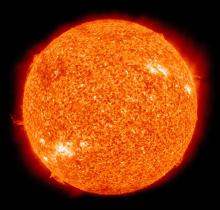Listen to today's episode of StarDate on the web the same day it airs in high-quality streaming audio without any extra ads or announcements. Choose a $8 one-month pass, or listen every day for a year for just $30.
You are here
Harold Weaver
More than five decades ago, astronomers at the University of California at Berkeley were using radio telescopes to study the Orion Nebula, a giant stellar nursery. They found an especially strong signal at an unexpected wavelength. The astronomers thought the signal might come from a mysterious molecule that no one had ever seen on Earth. So they gave it an appropriate name: mysterium.
They soon learned that it was a common molecule made of one oxygen atom and one hydrogen atom. The radio signal was especially strong because the molecules were being pumped up by infrared energy from gas clouds. That created a maser — the radio equivalent of a laser. It was the first maser ever discovered.
The Berkeley team was led by Harold Weaver, who was born 100 years ago this week.
In high school, Weaver built his own telescopes. He worked on military programs during World War II, then joined the Berkeley faculty in the early ’50s.
Radio astronomy was a young field, but it provided information that couldn’t be obtained with other techniques. Among other things, it revealed the presence of atoms and molecules in interstellar space. That allowed astronomers to trace where stars were being born.
Weaver established a radio astronomy lab and a big radio telescope. The telescope operated for three decades. Its accomplishments included discovering and mapping other masers in space.
Weaver died earlier this year — a pioneer at exploring the “mysteries” of the cosmos.
Script by Damond Benningfield





